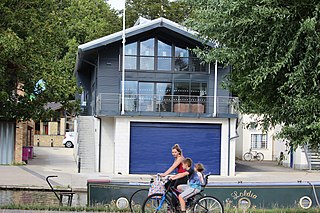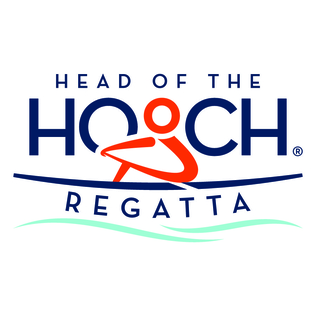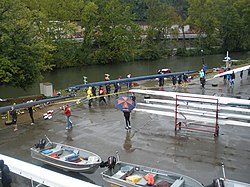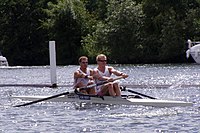
Rowing, sometimes called crew in the United States, is the sport of racing boats using oars. It differs from paddling sports in that rowing oars are attached to the boat using oarlocks, while paddles are not connected to the boat. Rowing is divided into two disciplines: sculling and sweep rowing. In sculling, each rower holds two oars—one in each hand, while in sweep rowing each rower holds one oar with both hands. There are several boat classes in which athletes may compete, ranging from single sculls, occupied by one person, to shells with eight rowers and a coxswain, called eights. There are a wide variety of course types and formats of racing, but most elite and championship level racing is conducted on calm water courses 2 kilometres (1.2 mi) long with several lanes marked using buoys.

Henley Royal Regatta is a rowing event held annually on the River Thames by the town of Henley-on-Thames, England. It was established on 26 March 1839. It differs from the three other regattas rowed over approximately the same course, Henley Women's Regatta, Henley Masters Regatta, and Henley Town and Visitors' Regatta, each of which is an entirely separate event.

The Head of the Charles Regatta, also known as HOCR, is a rowing head race held on the penultimate complete weekend of October each year on the Charles River, which separates Boston and Cambridge, Massachusetts United States. It is the largest 3-day regatta in the world, with 11,000 athletes rowing in over 1,900 boats in 61 events. According to the Greater Boston Convention & Visitors Bureau, the three-day event brings 225,000 people to the Greater Boston area and $72 million to the local economy.
Boat racing is a sport in which boats, or other types of watercraft, race on water. Boat racing powered by oars is recorded as having occurred in ancient Egypt, and it is likely that people have engaged in races involving boats and other water-borne craft for as long as such watercraft have existed.
The Head of the River is a name given to annual Australian rowing regattas held in South Australia, New South Wales, Victoria, Queensland, Tasmania and Western Australia. The regattas feature competing independent schools, and the winner of the 1st division boys or girls race is crowned the "Head of the River".

A head race is a time-trial competition in the sport of rowing. Head races are typically held in the fall, winter and spring seasons. These events draw many athletes as well as observers. In this form of racing, rowers race against the clock where the crew or rower completing the course in the shortest time in their age, ability and boat-class category is deemed the winner.

Rowing is the oldest intercollegiate sport in the United States. The first intercollegiate race was a contest between Yale and Harvard in 1852. In the 2018–19 school year, there were 2,340 male and 7,294 female collegiate rowers in Divisions I, II and III, according to the NCAA. The sport has grown since the first NCAA statistics were compiled for the 1981–82 school year, which reflected 2,053 male and 1,187 female collegiate rowers in the three divisions. Some concern has been raised that some recent female numbers are inflated by non-competing novices.
University rowing in the United Kingdom began when it was introduced to Oxford in the late 18th century. The first known race at a university took place at Oxford in 1815 between Brasenose and Jesus and the first inter-university boat race, between Oxford and Cambridge, was rowed on 10 June 1829.
The Scullers Head of the River Race is a rowing race held annually on the River Thames Championship Course from Mortlake to Putney, open to single scullers only. The race is held in November or early December each year on a week usually to suit the mid-morning or mid-afternoon timing of the ebb tide.
The Poughkeepsie Regatta was the annual championship regatta of the U.S. Intercollegiate Rowing Association (IRA) when it was held in Poughkeepsie, New York from 1895 to 1949.

Durham University Boat Club (DUBC) is the rowing club of Durham University. In recent years, DUBC has cemented itself as one of the strongest university boat clubs in Great Britain. Under the leadership of former British Olympian Wade Hall-Craggs, DUBC notably won the BUCS Victor Ludorum for ten consecutive years (2004-2013), and has produced a number of athletes that have competed internationally at European and World Championship level.

National Schools' Regatta is the largest rowing regatta for junior rowers in Great Britain. Held annually in May, the three day regatta offers events for junior rowers between the categories J14 and J18.

The Victorian Head of the Schoolgirls regatta is contested between girls at schools from all across the state of Victoria Australia. Schools from the Girls Sport Victoria (GSV) and also Associated Public Schools of Victoria (APS), as well as smaller school rowing groups which enter under a rowing club banner, compete in a range of events over 1000m for the Year 9 and Year 10 events or 1500m for the Open events.

City of Cambridge Rowing Club (CCRC) is the oldest 'town' rowing and sculling club in Cambridge, UK, and with about 300 members, it has one of the largest active rowing memberships in the region. The club's colours are dark blue, with a band of claret sandwiched between two bands of 'old gold'.

Durham School Boat Club (DSBC) is a school club offering rowing to students, parents, friends and other local schools. Based at Durham School in the city of Durham, England.
Monmouth Rowing Club is located on the banks of the River Wye in Monmouth, the county town of the historic county of Monmouthshire, Wales. The club is affiliated with the Welsh Amateur Rowing Association (WARA) and hosts several annually organised race events.

The Head of the Hooch Regatta, previously known as the Head of the Chattahoochee Regatta, is a 2-day rowing regatta held annually on the first full weekend in November in Chattanooga, Tennessee. The head race is currently run downstream on a 3.1 miles (5.0 km) course on the Tennessee River. It presently ranks as one of the largest rowing regattas in the United States with over 10,000 rowers and over 2,100 boats entered for the 2014 event. 1,245 boats raced on one day in the 2012 competition, more than any other US regatta on a single day.

Cantabrigian Rowing Club, known as Cantabs, is a 'town' rowing and sculling club in Cambridge, UK.

The Thomas Eakins Head of the Schuylkill Regatta is a rowing race held annually during the last weekend in October on the Schuylkill River in Philadelphia, Pennsylvania. The HOSR is the final race in the Fall Fury series, which includes the Head of the Ohio and the Head of the Connecticut. Along with the Head of the Charles and the Head of the Connecticut, the HOSR is considered one of the three “fall classics.” The HOSR is one of the marquee races in the Philadelphia Classic Regatta Series, which also includes the Stotesbury Cup Regatta, the Philadelphia Scholastic Rowing Championship, the Schuylkill Navy Regatta, and the Independence Day Regatta.
Regattas such as the Head of the Charles in Boston and the Head of the Schuylkill in Philadelphia are to the rowing world what the New York Marathon and the Boston Marathon are to running.

Reading University Boat Club is the rowing club for the University of Reading in the United Kingdom. It is based at a boat house in Christchurch Meadows on the River Thames in the Reading suburb of Caversham. The club has a focus on sculling. It has consistently been one of the more successful university rowing clubs in Britain, including topping the medal table at the BUCS regatta in 2011 and at the BUCS small boats head in 2014 and 2015, as well as wins at Henley Royal Regatta in 1986, 2008, 2009, 2010, 2011 and 2013, and is considered one of the top six university rowing clubs in the UK. A number of former members have competed at the Olympics, including double gold-medallists James Cracknell and Helen Glover. The club has organised the Reading University Head of the River race since 1935.















